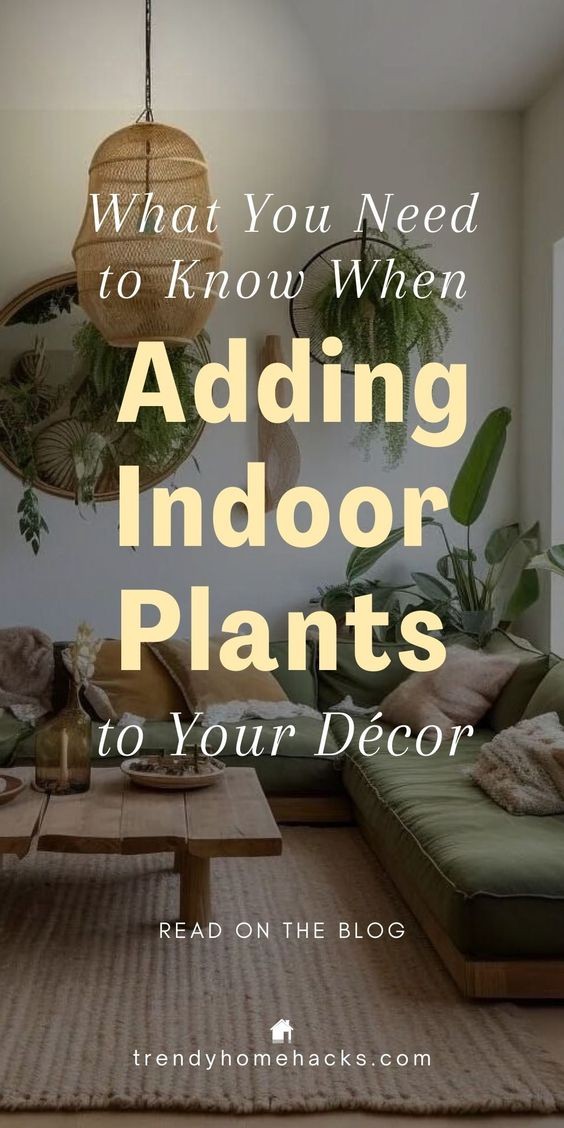Essential Tips for Adding Indoor Plants to Your Décor
Indoor plants can breathe new life into any space, adding freshness, color, and a touch of nature to your décor. Whether you're a seasoned plant enthusiast or a newbie looking to green up your home, incorporating indoor plants can be both fun and rewarding. Here’s a guide to help you effectively add indoor plants to your décor, ensuring they thrive and enhance your living space.
1. Choose the Right Plants
Selecting the right plants for your space is crucial. Consider the following factors:
Light Conditions: Assess the light levels in your home. Some plants thrive in bright, direct light, while others prefer low-light conditions. For example, succulents and cacti love bright light, whereas snake plants and pothos are perfect for low-light areas.
Space and Size: Choose plants that fit your space. Large plants like rubber trees work well in spacious rooms, while smaller plants like succulents or air plants are ideal for smaller spaces or shelves.
Maintenance Level: Consider how much time you can dedicate to plant care. Low-maintenance plants like ZZ plants or peace lilies are great for beginners, while more demanding plants like orchids may require more attention.
2. Incorporate Plants into Your Design
Plants can be seamlessly integrated into various design styles. Here’s how to blend them into your décor:
Color Coordination: Match plant pots with your room’s color scheme. Choose neutral-colored pots for a minimalist look or vibrant, patterned pots to add a pop of color.
Style and Aesthetics: Consider your home’s aesthetic. Sleek, modern pots work well in contemporary spaces, while rustic or vintage pots can complement a farmhouse or eclectic style.
Placement: Place plants strategically to enhance your décor. Use plant stands or hanging planters to elevate plants and create visual interest. Group plants of varying heights and textures to add depth and dimension.
3. Create a Plant Display
A well-curated plant display can be a stunning focal point:
Shelving Units: Arrange plants on shelves to create a layered effect. Mix different heights and types of plants for an eye-catching display.
Plant Corners: Dedicate a corner of a room to a collection of plants. Use a mix of tall and trailing plants to create a lush, green nook.
Hanging Plants: Hang plants from the ceiling or wall-mounted planters to add greenery at eye level. Macramé hangers or stylish planters can enhance the visual appeal.
4. Consider Plant Care and Maintenance
Proper care ensures your plants remain healthy and vibrant:
Watering: Understand the watering needs of each plant. Overwatering is a common issue, so ensure pots have good drainage and water plants according to their specific needs.
Humidity: Some plants thrive in higher humidity. If you have plants that need extra moisture, consider using a humidity tray or placing a small humidifier nearby.
Cleaning: Dust plant leaves regularly to keep them healthy and to maintain their aesthetic appeal. Wipe leaves with a damp cloth or use a gentle spray of water.
5. Incorporate Plants into Functional Spaces
Plants can also serve practical purposes:
Air Purification: Many indoor plants help purify the air. Incorporate plants like spider plants, peace lilies, or bamboo palms to improve air quality.
Room Dividers: Use tall plants to create natural dividers in open spaces or to section off areas in a room, adding both functionality and style.
Workspace: Place plants in your home office or workspace to boost productivity and create a calming environment.
6. Experiment with Plant Combinations
Mixing different types of plants can add variety and interest:
Complementary Plants: Combine plants with different textures and shapes to create a balanced look. Pair leafy plants with succulents or add trailing plants to a tall plant for a dynamic display.
Color Contrast: Use plants with contrasting colors or variegated leaves to create visual interest. The combination of different shades of green and other colors can enhance your décor.
7. Embrace Seasonal Plants
Incorporate seasonal plants to keep your décor fresh:
Spring and Summer: Opt for vibrant, flowering plants like begonias or geraniums. Fresh herbs like basil or mint can also add a touch of greenery and fragrance.
Fall and Winter: Choose plants with rich, deep colors or those that thrive in cooler temperatures. Consider adding festive touches with seasonal decorations.
Conclusion
Adding indoor plants to your décor is a wonderful way to bring life and vibrancy to your home. By choosing the right plants, integrating them thoughtfully into your design, and providing proper care, you can create a beautiful and refreshing environment. Whether you’re aiming for a lush indoor jungle or a few strategically placed greens, these essential tips will help you make the most of your indoor plants and enhance your living space.






